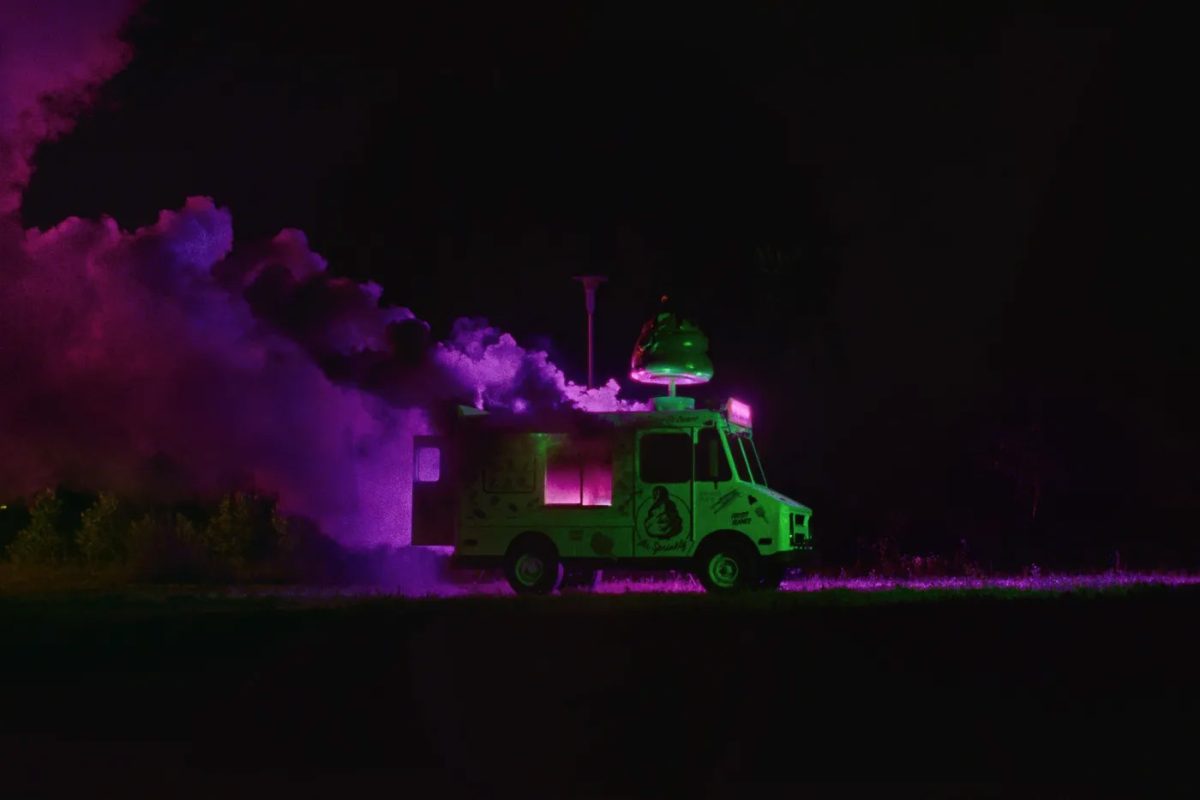Who hasn’t gotten a little too invested in a TV show? Everyone has a show from which they can recite entire monologues, have the soundtrack playing on repeat, and even know all the behind-the-scenes drama. In their newest film, I Saw The TV Glow, director Jane Schoenbrun explores how such an innocent interest can turn into a darker obsession, making you doubt reality as fiction and fact collide. Simultaneously, the film presents Schoenbrun’s perspective on the complex and often conflicting emotions of the trans experience. After a sold-out screening at the Chicago Critics Film Festival and a successful festival run, I Saw The TV Glow has the potential to become a cult classic.
I Saw The TV Glow follows Owen (Justice Smith), a suburban teenager whose life is forever changed after his classmate Maddy (Brigette Lundy-Paine) introduces him to The Pink Opaque, a young adult TV show about two girls who fight supernatural monsters using their psychic connection. One day, the show is canceled and Maddy disappears under mysterious circumstances, leaving Owen lost and adrift. Years later, Maddy resurfaces looking for Owen, warning him that his reality and the world of The Pink Opaque might be more intertwined than he ever imagined.
The power in I Saw The TV Glow lies in Schoenbrun’s ability to unpack the motivations that drive obsession. Instead of taking the easy route and conflating the characters’ interests with immaturity, Schoenbrun recognizes Owen and Maddy’s interest as a craving for a new life. The Pink Opaque allows them to wonder if there is more for them than their current reality, beyond their unwelcoming homes and confused selves. One memorable expression of this occurs when Maddy tells Owen, “This isn’t how life is supposed to feel,” pointing to that inescapable desire for change that only finds solace in the TV world. This sentiment grows stronger as the film progresses and the characters grow up. Even once Owen is no longer a kid, Schoenbrun still portrays him as isolated from his surroundings, navigating his daily responsibilities almost like a ghost. His thoughts, expressed in voice-over, are rarely concerned with the present moment, as he still reminisces about Maddy and The Pink Opaque. This dissonance represents the substantial gap between his current life and the places where his mind wanders. The constant push and pull between his world and the desire for an escape is destabilizing, forming a perfect foundation for the film’s exploration of the psychological horror genre. This is articulated through the slightly unnerving feeling that prevails throughout the film, sometimes coming in the form of Maddy’s deadpan delivery or the cinematography, which often illuminates dark spaces with striking neon lights or flickering from the TV set glow—perfectly owning the film’s title.
The soundtrack, including two on-screen musical performances, stands out for its reflection of both the film’s shattering reality and the characters’ nostalgia for their fading youth. Perfectly encapsulating the characters’ striving for a world like the one on TV, the song “Claw Machine” declares, “I think I was born blue, I think I was born wanting more.” During the Q&A at the Chicago Critics Film Festival, Jane Schoenbrun explained their heavy involvement in bringing together these songs, working closely with some modern indie icons like Caroline Polacheck, Sloppy Jane, and Phoebe Bridgers, as well as celebrating up-and-coming artists like yule and the band Sadurn. The full album will be on heavy rotation for me, even given the risk of inviting an existential crisis.
Furthermore, amidst the chaos and suspense of I Saw The TV Glow lies a powerful reflection on the director’s journey navigating the unique emotions that come with being a trans person. What’s even more remarkable is Schoenbrun’s capacity to fully exploit the richness of the film’s genre and its cinematic language to both convey a personal experience and provide LGBTQ+ audiences with a voice in a space that has historically neglected their stories. The uneasiness that haunts Owen as the lines between the show and his life blur mirrors the inner conflicts of many queer individuals who must navigate their identity under distressing circumstances. The audience holds their breath for Owen, hoping for clarity and an answer to the strange happenings of the film. In this way, Schoenbrun uses suspense to help the audience understand the all-consuming pressure of uncertainty that comes from doubting and changing one’s identity. As obvious as it might sound to many audiences, it sometimes seems like the industry needs reminders that trans stories are not only necessary and deserving of being told, but that they can be more than simple retellings or memoirs. Instead, they can use established conventions to subvert expectations and provide the medium with fresh perspectives. Jane Schoenbrun’s I Saw The TV Glow, distributed by A24, is evidence of the excellence that can reach our screens when queer creative voices are supported.









